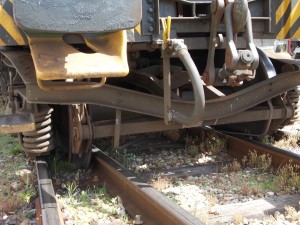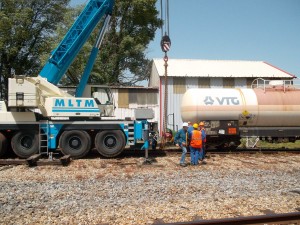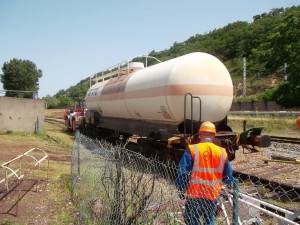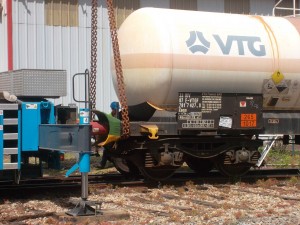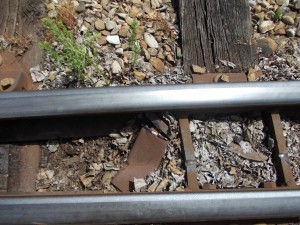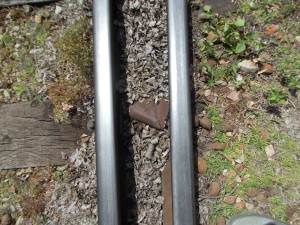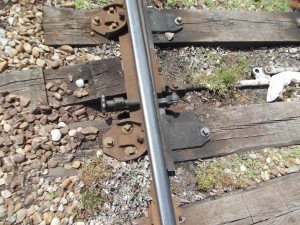Around 7:40 am, at a chemicals plant, a 57-tonne liquefied chlorine (Cl2) railcar derailed for an unknown reason near a switch between one set of tracks leading to the factory and another to the transfer station. 2 front bogie wheels left the rails, but the car stabilised (6 wheels remained on the track), and no toxic leak was reported.
The site activated its internal emergency plan at 9 am. A crane was needed to reposition the car onto the rails. According to internal procedures and although no specific rule had been established for this type of situation, the plant operator devised a lifting plan and work authorisation, yet without any accompanying prevention plan. The inspector of classified facilities, alerted around 10 am, observed during the morning hours that the wheels had derailed downstream of the switches and upstream of the switching box. 2 thrust bearing spacers were sheared on both sides while others were deformed.
Neither the railcar rolling speed nor the reason for this switching malfunction could be determined. The assigned subcontractor attached one of the switches to the fixed rail using a vice and the car was then led to its parking zone. Several handling steps were needed, given the presence of a fully loaded railcar parked in the dedicated zone and an empty car in the transfer unit, i.e.: moving the empty car, and transferring one full car to the transfer station and the other to a parking zone. The emergency plan was lifted at 1:40 pm.
The inspector of classified facilities noted the long time interval between the incident and the emergency plan activation, plus the presence of 2 cars filled with Cl2 on the track. The operator was asked to submit a report listing: event chronology, causes identified, and corrective actions aimed at avoiding comparable incidents. The operator was also required to have the railcar wheels and bogies evaluated and take steps to prevent having 2 tanker cars full of Cl2 being transported on-site. When the transferred railcar is empty, the on-site arrival of a new full Cl2 car will be contingent upon completing back-and-forth manoeuvres between the full car in a parked position and the empty Cl2 car in the transfer zone. As for track condition, the operator indicated that the subcontractor responsible for track monitoring and railcar logistics for the municipality’s 3 sites was conducting annual track audits, with the most recent one (Feb 2012) reporting on outstanding works. It was also noted that the switches were being lubricated manually. The operator had to confirm to the inspector of classified facilities that the works allocated in the audit had actually been completed and that the deteriorated thrust bearing or spacer parts had been quickly replaced. A certified body was requested to inspect within 3 months the various switches and associated components, on which the Cl2 cars might be routed, for: wear of switches and thrust bearings / spacers, geometry / spacing / spot heights, clamping and resistance of the ties, straightening and levelling. Control reports and corresponding action plans were to be made available to inspection authorities. The operator insisted that the contracted body inspect railcars upon their acceptance at a service area before reaching the site; this inspection however was neither formalised nor recorded even though the body had written an operating protocol. During connection inside the transfer zone once the car had been parked on-site, the operator took its turn to verify the Cl2 cars using a checklist.
Since railcar inspections prior to reaching the site lacked any formalism or recordkeeping, facilities inspectors requested that the operator formalise tanker car controls before entering the site (checklist, tanker documentation, etc.) and draft a procedure in cases of recognized non-compliance so as to ensure railcar and pipe safety. Railcar speed was also supposed to be checked and all handling performed by qualified personnel. An update was to be provided of the certifications held by on-site personnel or individuals handling the Cl2 tanker cars.



